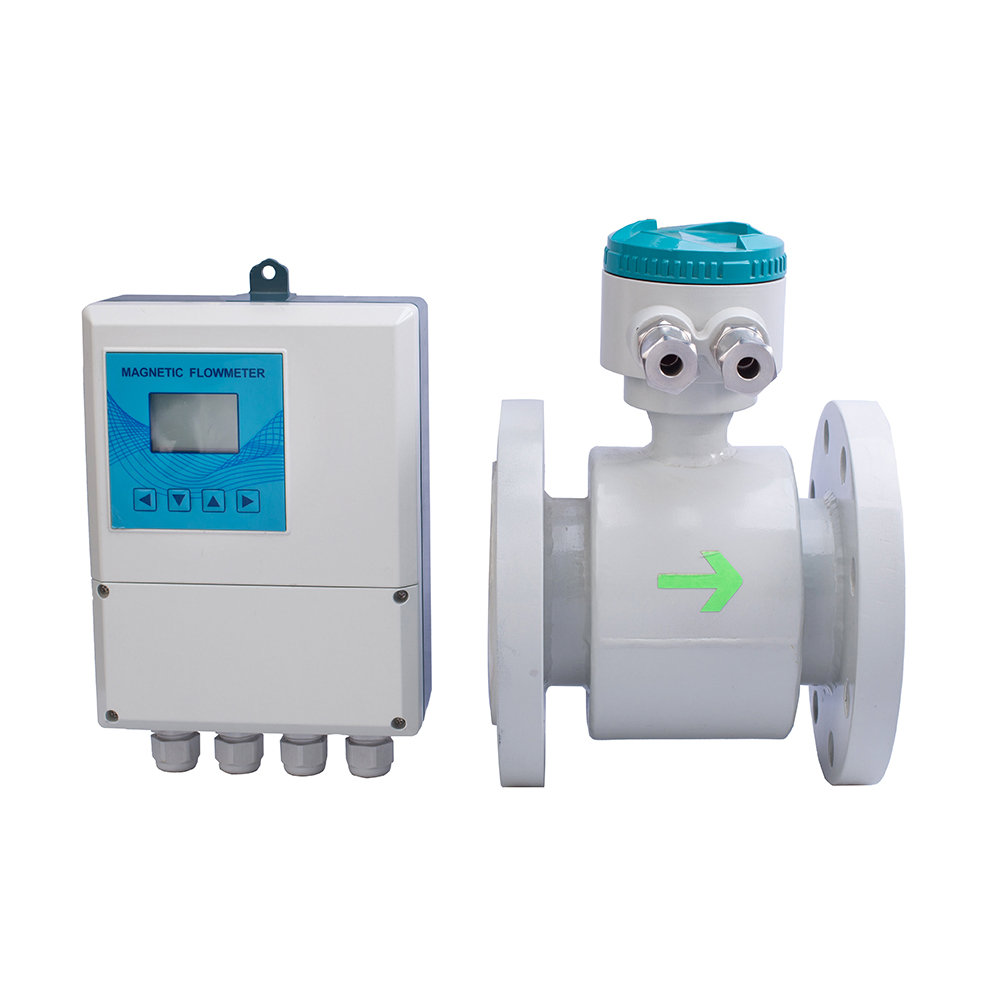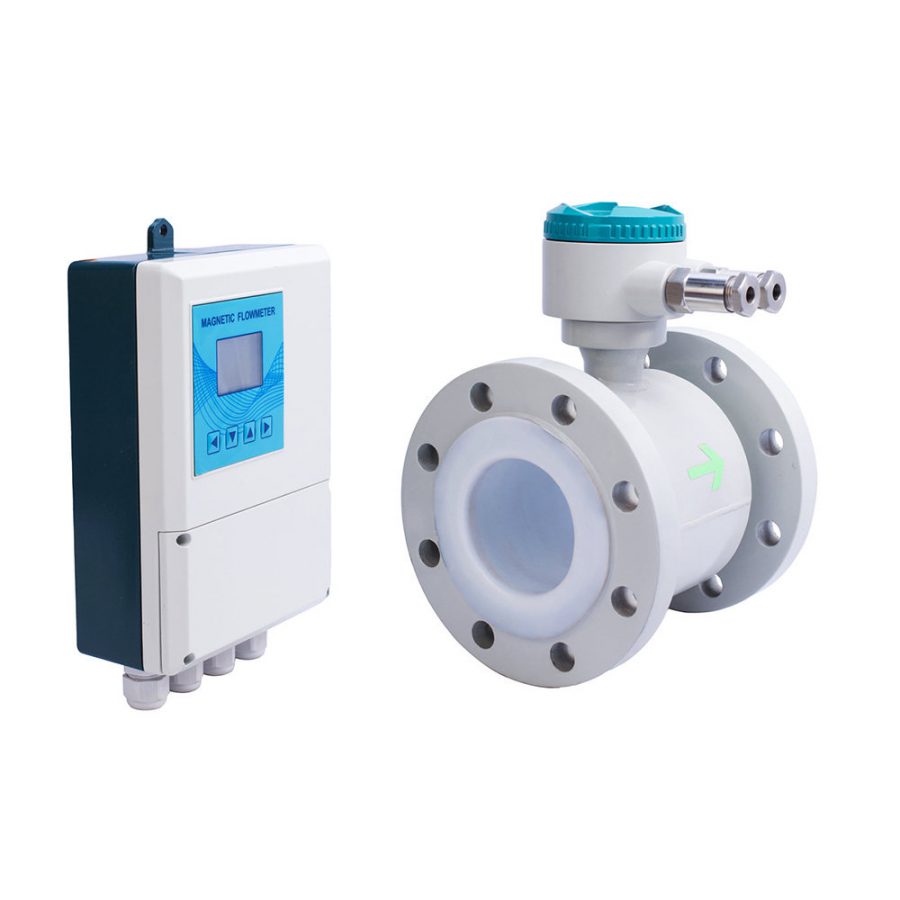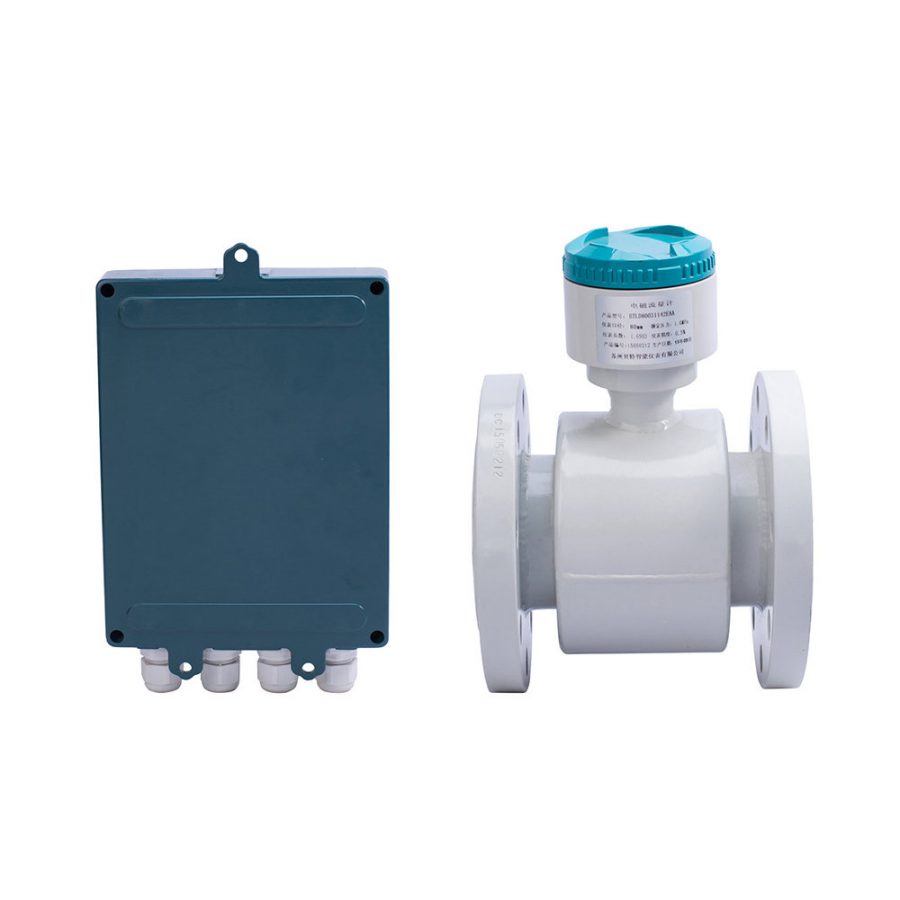Principle and structure
The measurement principle of an electromagnetic flowmeter is based on Faraday's law of electromagnetic induction. The sensor primarily consists of a measuring tube with an insulating lining, a pair of electrodes installed through the tube wall, a pair of coils, and an iron core that generates an operating magnetic field.
Electromagnetic flowmeters can be used to measure the volume flow of conductive liquids in closed pipes. They are widely used for flow measurement and control in the chemical and petroleum industries, metallurgy, water supply and drainage, agricultural irrigation, papermaking, food and beverage, and pharmaceutical industries.
Product features
1. Measurement is not affected: The measurement is not affected by changes in fluid density, viscosity, temperature, pressure and conductivity.
2. No obstruction to flow components: There are no obstruction to flow components in the measuring tube, no pressure loss, and the straight pipe section requirements are low.
3. Series nominal diameter: The series nominal diameter is DN15~DN3000, and there are many options for sensor lining and electrode materials.
4. Novel excitation method: The converter adopts a novel excitation method with low power consumption, stable zero point and high accuracy. The flow range can reach 1500:1.
5. Converter: The converter can be integrated or separated with the sensor.
6. Reliable programming: The converter adopts a 16-bit high-performance microprocessor and 2x16LCD display, which is convenient for parameter setting and reliable programming.
7. Bidirectional measurement system: The flow meter is a bidirectional measurement system with three integrators: forward total, reverse total and differential total; it can display reverse flow and has multiple outputs: current, pulse, digital communication, HART.
8. Surface mounting technology: The converter adopts surface mounting technology and has self-test and self-diagnosis
Implementation standards
| Implementation standards |
JB/T 9248~1999 |
| Nominal diameter |
10, 15, 20, 25, 32, 40, 50, 65, 80, 100, 125, 150, 200, 250, 300, 350, 400, 500, 600, 700, 800, 900, 1000, 1200, 1400, 1600, 1800, 2000, 2200, 2400, 2600, 2800, 3000 |
| Upper limit flow rate |
15m/s |
| Accuracy |
DN15~DN600 |
Displayed value: ±0.3% flow rate ≥1m/s; ±3mm/s flow rate <1m/s |
| DN700~DN3000 |
Displayed value ±0.5% flow rate ≥0.8m/S; ±4mm/s flow rate <0.8m/S |
| Fluid conductivity |
≥5uS/cm |
| Nominal pressure |
4.0MPa |
1.6MPa |
1.0MPa |
0.6MPa |
6.3、10MPa |
| DN15~DN150 |
DN15~DN600 |
DN200~DN1000 |
DN700~DN3000 |
Special order |
| Ambient temperature |
Sensor |
-25℃- +60℃ |
| Converter and integrated type |
-10℃- +60℃ |
| Lining material |
PTFE, polychloroprene rubber, polyurethane, polytetrafluoroethylene propylene F46, meshed PFA |
| Upper limit fluid temperature |
Integrated type |
70℃ |
| Separate type |
Neoprene lining |
80℃; 120℃ |
| Polyurethane lining |
80℃ |
| PTFE lining |
100℃; 150℃ |
| FEP F46 |
| PFA with mesh |
Structural material: lining material
| Lining material |
Main performance |
Upper limit medium temperature |
Scope of application |
|
|
—Body type |
Separation type |
|
| Polytetrafluoroethylene (F4) |
It is a plastic with stable chemical properties. It is resistant to strong acids,strong alkalis and organic solvents,but not resistant to corrosion from high-flow liquid fluorine,liquid oxygen and ozone. |
70℃ |
100℃ 、150℃ |
1、Strongly corrosive media such as concentrated acid and alkali. 2、Sanitary media. |
| Fluorinated ethylene propylene (F46) |
Same as F4, with higher wear resistance and negative pressure resistance than F4. |
|
Same as above |
|
| Polyfluoroethylene (Fs) |
The upper limit of applicable temperature is lower than that of polytetrafluoroethylene. |
|
80℃ |
|
| Polychloroprene rubber |
1, Good elasticity and good wear resistance. 2, Resistant to corrosion by general low-concentration acid, alkali, and salt media |
|
80℃ 120℃ |
Water, sewage, weakly abrasive mud and slurry. |
| Polyurethane rubber |
1, strong wear resistance. |
|
80℃ |
Neutral and strong wear slurry, coal slurry, mud |
| 2, poor corrosion resistance. |
Electrode material
| Electrode material |
Corrosion and wear resistance |
| Stainless steel 0Crl8Nil2M02Ti |
Applicable to industrial, municipal and environmental protection fields, used for conveying or processing weakly corrosive media. |
| Hastelloy B |
Resistant to corrosion by hydrochloric acid of all concentrations (below boiling point) and non-oxidizing acids, alkalis and salts. |
| Hastelloy C |
Resistant to corrosion by non-oxidizing acids and oxidizing salts, including mixed acids, hypochlorites and seawater. |
| Titanium |
Resistant to oxidizing media, such as seawater, hypochlorite, and oleum. Not resistant to pure reducing acid, but oxidants can greatly alleviate corrosion. |
| Tantalum |
Corrosion resistance is similar to glass, resistant to most chemical media except hydrofluoric acid, oleum and alkali. |
| Platinum/titanium alloy |
Resistant to almost all chemical media, but not suitable for aqua regia and ammonium salts. |
| Stainless steel coated with tungsten carbide |
For non-corrosive and highly abrasive media. |
| Note: Corrosion is affected by working conditions. This table is for reference only. It is recommended that users conduct corrosion resistance tests and select materials based on actual conditions. |
Reference flow range
| Diameter mm |
Flow range m3/h |
Diameter mm |
Flow range m3/h |
| φ10 |
0.16~2.5 |
φ400 |
250~4000 |
| φ15 |
0.4~6 |
φ500 |
400~6000 |
| φ20 |
0.6~12 |
φ600 |
600~10000 |
| φ25 |
1.0~16 |
φ700 |
800~12000 |
| φ32 |
1.6~25 |
φ800 |
1000~16000 |
| φ40 |
2.5~40 |
φ900 |
1200~20000 |
| φ50 |
4.0~60 |
φ1000 |
1600~25000 |
| φ65 |
6.0~120 |
φ1200 |
2500~30000 |
| φ80 |
10~160 |
φ1400 |
3000~50000 |
| φ100 |
16~250 |
φ1600 |
3000~60000 |
| φ125 |
25~400 |
φ1800 |
5000~60000 |
| φ150 |
40~600 |
φ2000 |
6000~100000 |
| φ200 |
60~1000 |
φ2200 |
1367.78~136778.4 |
| φ250 |
100~1600 |
φ2400 |
1627.78~162777.6 |
| φ300 |
160~2500 |
φ2600 |
1910.38~191037.6 |
| φ350 |
200~3000 |
|
|



